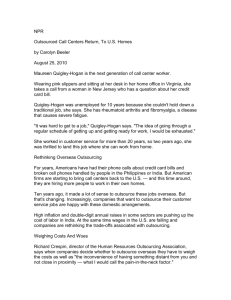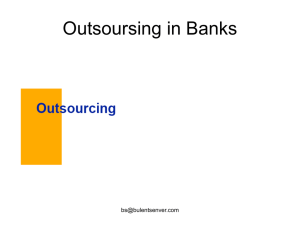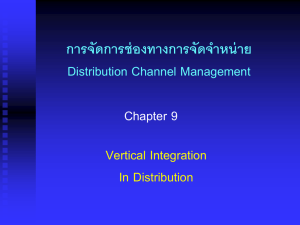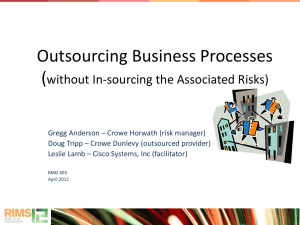A plan for success
advertisement
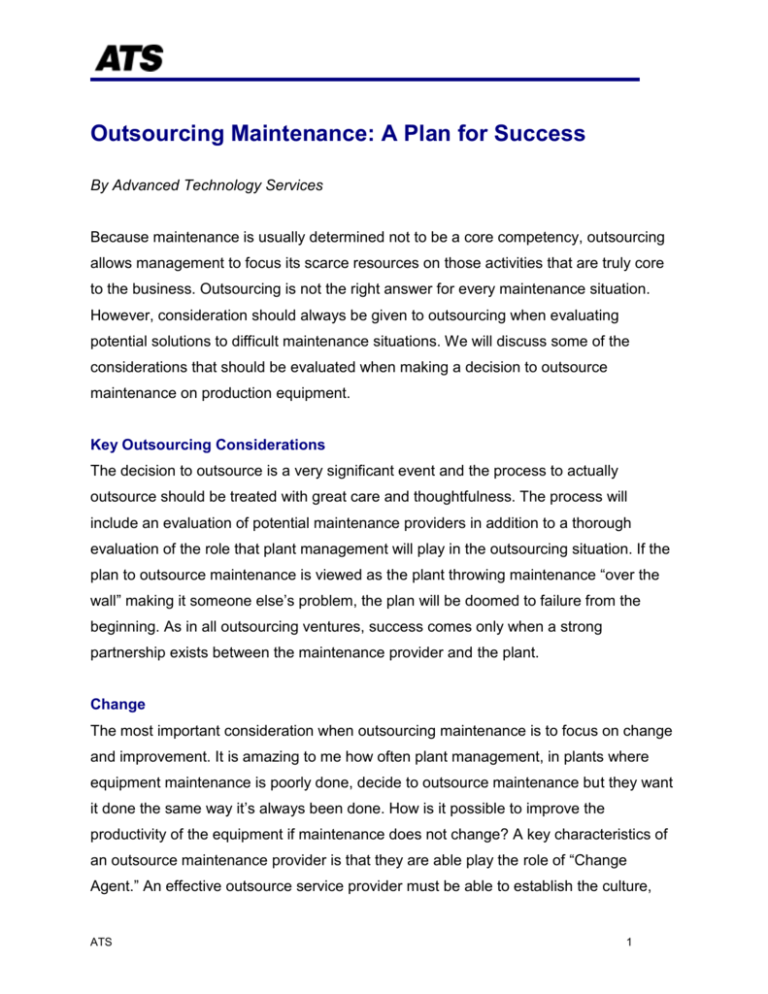
Outsourcing Maintenance: A Plan for Success By Advanced Technology Services Because maintenance is usually determined not to be a core competency, outsourcing allows management to focus its scarce resources on those activities that are truly core to the business. Outsourcing is not the right answer for every maintenance situation. However, consideration should always be given to outsourcing when evaluating potential solutions to difficult maintenance situations. We will discuss some of the considerations that should be evaluated when making a decision to outsource maintenance on production equipment. Key Outsourcing Considerations The decision to outsource is a very significant event and the process to actually outsource should be treated with great care and thoughtfulness. The process will include an evaluation of potential maintenance providers in addition to a thorough evaluation of the role that plant management will play in the outsourcing situation. If the plan to outsource maintenance is viewed as the plant throwing maintenance “over the wall” making it someone else’s problem, the plan will be doomed to failure from the beginning. As in all outsourcing ventures, success comes only when a strong partnership exists between the maintenance provider and the plant. Change The most important consideration when outsourcing maintenance is to focus on change and improvement. It is amazing to me how often plant management, in plants where equipment maintenance is poorly done, decide to outsource maintenance but they want it done the same way it’s always been done. How is it possible to improve the productivity of the equipment if maintenance does not change? A key characteristics of an outsource maintenance provider is that they are able play the role of “Change Agent.” An effective outsource service provider must be able to establish the culture, ATS 1 attitude, and discipline in the maintenance team that exists in other departments in the organization. Maintenance improvement A common mistake that is made when considering whether to outsource maintenance or keep it inside is focusing solely on the ability to reduce the cost of maintenance. There is no question that reducing costs is a key element in any outsourcing decision. Reducing the cost of maintenance contributes, albeit in a small way, to improving the bottom line of a manufacturing plant. However, effective maintenance contributes, in a big way, to reducing the overall cost to produce. Maintenance that is able to increase the availability of production equipment can contribute 5%-10% to the bottom-line profitability of the plant. In the cases where effective maintenance can improve equipment availability, looking to only reduce maintenance cost is like stepping over dollars to pick up pennies. Comprehensive approach Another common outsourcing mistake made by manufacturing plants is focusing outsourcing efforts on the labor component only. The idea is that the service provider is able to have their people do the maintenance better than the in-house staff and this will solve the problem. Nothing could be further from the truth. Generally 85% of all problems are related to poor processes and 15% are related to people. When maintenance performance is poor, it is imperative that the maintenance process is addressed before the people issues. This means that all aspects of maintenance must be scheduled for improvement. In addition to the labor component, improvement should be included in each of the maintenance processes (i.e., work order process, proactive maintenance process, parts process, etc), maintenance leadership, maintenance spare parts and supplies, a Computerized Maintenance Management System (CMMS), and maintenance tools and technologies. The outsource service provider must be able to address and impact all aspects of the maintenance system if successful improvement is to be enacted in the availability of production equipment. ATS 2 Managing the outsource relationship It is interesting to observe the short-term development of various outsourcing relationships. All too often, the manufacturing plant outsources maintenance in order to “get it off their plate.” The desire is to dump maintenance into the lap of the outsource provider, making it their problem. This scenario is a guaranteed formula for failure. Whether you outsource maintenance or perform it with your in-house maintenance staff, plant management must always be involved in the maintenance function. In outsourcing, plant management will tend to manage the results of maintenance more than they will manage the activities of maintenance. The foundation for all outsourcing relationships should be mutual gain and a win-win environment. A true partnership relationship, based on mutual trust, must be well understood and exist between the plant and the service provider. Additionally, it is important that the service provider, and all of their people, is viewed as a part of the plant team. All too often, the service provider is treated as an outsider by the front line as well as management. They are “those maintenance people.” This creates an “us versus them” environment that inhibits improvement and prevents maximum plant effectiveness. The service provider should be allowed to take part in plant social activities, be included in plant communications, and participate in safety and other training programs. Maintenance best practices One of the real benefits of outsourcing equipment maintenance is the ability to gain exposure to all of the maintenance best practices, which include: 1. Maintenance Leadership 2. Planned/Scheduled Maintenance 3. Preventive/Predictive Maintenance 4. Reliability Improvement 5. Maintenance Materials Management 6. Contractor Relations ATS 3 7. Human Resource Development 8. Maintenance Technologies Maintenance organizations have intelligent, hard-working, dedicated people who could eventually implement best practices in any, and maybe all, of these areas. However, most maintenance people’s time is spent reacting to fires, fixing machines that have gone down, searching out a part that is needed on a down machine, etc. It is difficult to implement best practices when there is little time to do anything but react. By outsourcing the maintenance function to the right service provider, the plant gains rapid access to all of these maintenance best practices. The opportunity for change is almost immediate. Performance measurements Have you ever heard the adage “if you do not measure it, you cannot improve it.” This is absolutely the case when it comes to maintenance improvement. Maintenance should never be outsourced to any service provider who cannot demonstrate a history of collecting maintenance data and reporting performance metrics for continuous improvement. If decision-making is going to become fact-based, having access to information is essential. The pre-requisite for data collection and metric reporting is a Computerized Maintenance Management System (CMMS). The CMMS is the heart of any maintenance improvement effort and I am convinced that equipment maintenance improvement is impossible without an effective CMMS process. It just cannot be done. Measuring the effectiveness of maintenance has always been a difficult task. The things that maintenance has traditionally measured are really operational metrics. For example, machine availability is a traditional maintenance measurement. However, if you really think about the things that impact machine availability they include, among other things: 1. Operator Training 2. Quality of raw material ATS 4 3. Proactive maintenance program 4. Age and quality of the machine itself Maintenance is certainly a contributor to machine availability, but clearly not the sole determinant. Therefore, maintenance cannot be held singularly responsible for this particular metric. Metrics that better measure the success of an outsourced maintenance program might be maintenance cost per unit of production. As production goes up, the cost per unit should be going down. Similarly, as production is reduced, maintenance costs must go down in like manner. Another measurement of maintenance might be Proactive Maintenance compliance. Perhaps the fill rate on maintenance parts out of the storeroom would be an effective measurement. Whatever measurement you use, make sure that maintenance is effectively driving down the total cost to produce and improving the profit line. Continuous improvement must be the mantra of an effective maintenance organization. Plan for success In summary, it is clear that outsourcing production equipment maintenance is a decision that should be considered if improved maintenance is required. It is certainly not a decision that should be taken lightly. Once the decision is made to outsource, the process to implement such a program should be thoughtful and well planned. If implemented properly, an outsourced maintenance program can be an extremely positive experience for all involved. As long as all parties remember why maintenance is being outsourced, understand the objectives of the program, and continually review expectations of the plant and of the service provider, the program will be successful and provide the desired results to the plant. ATS 5


